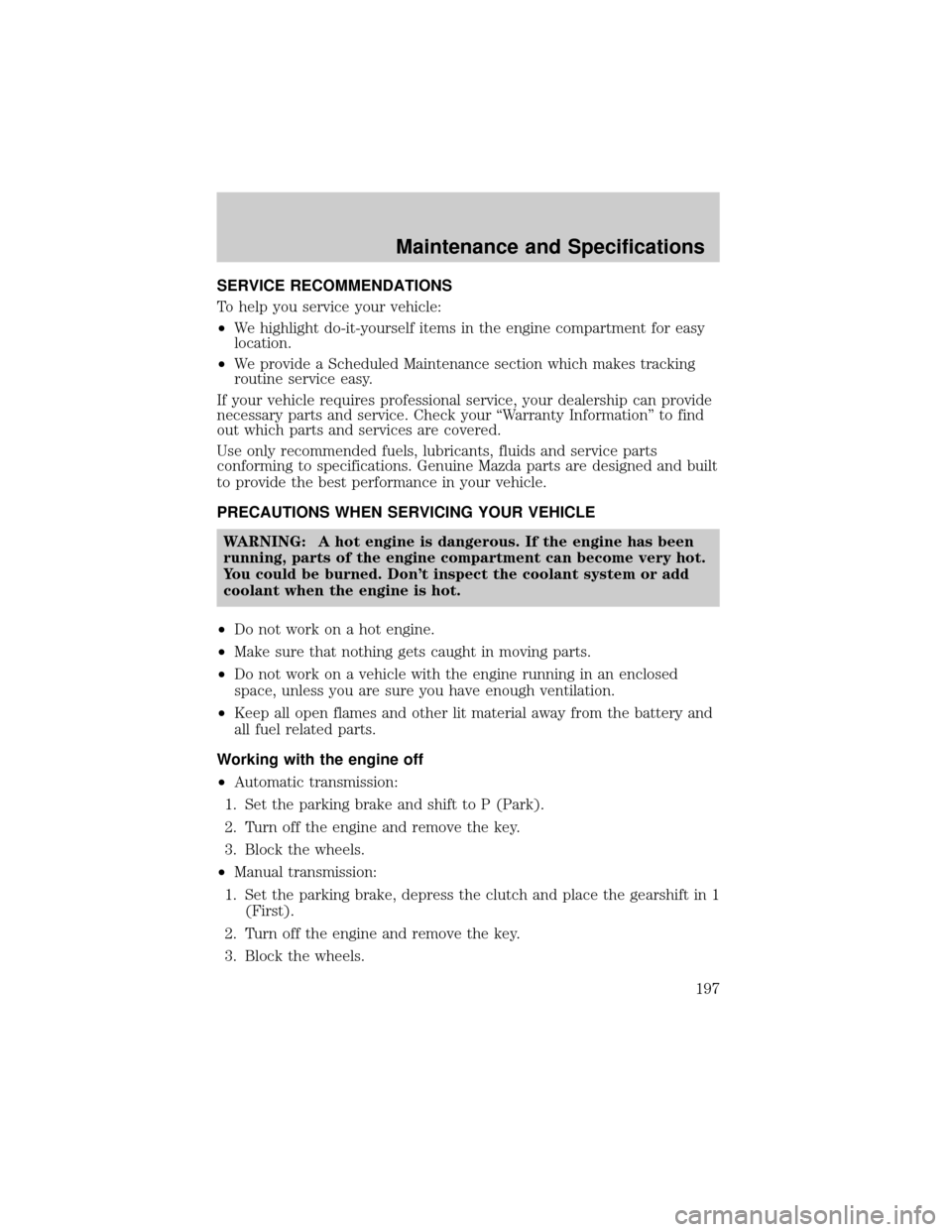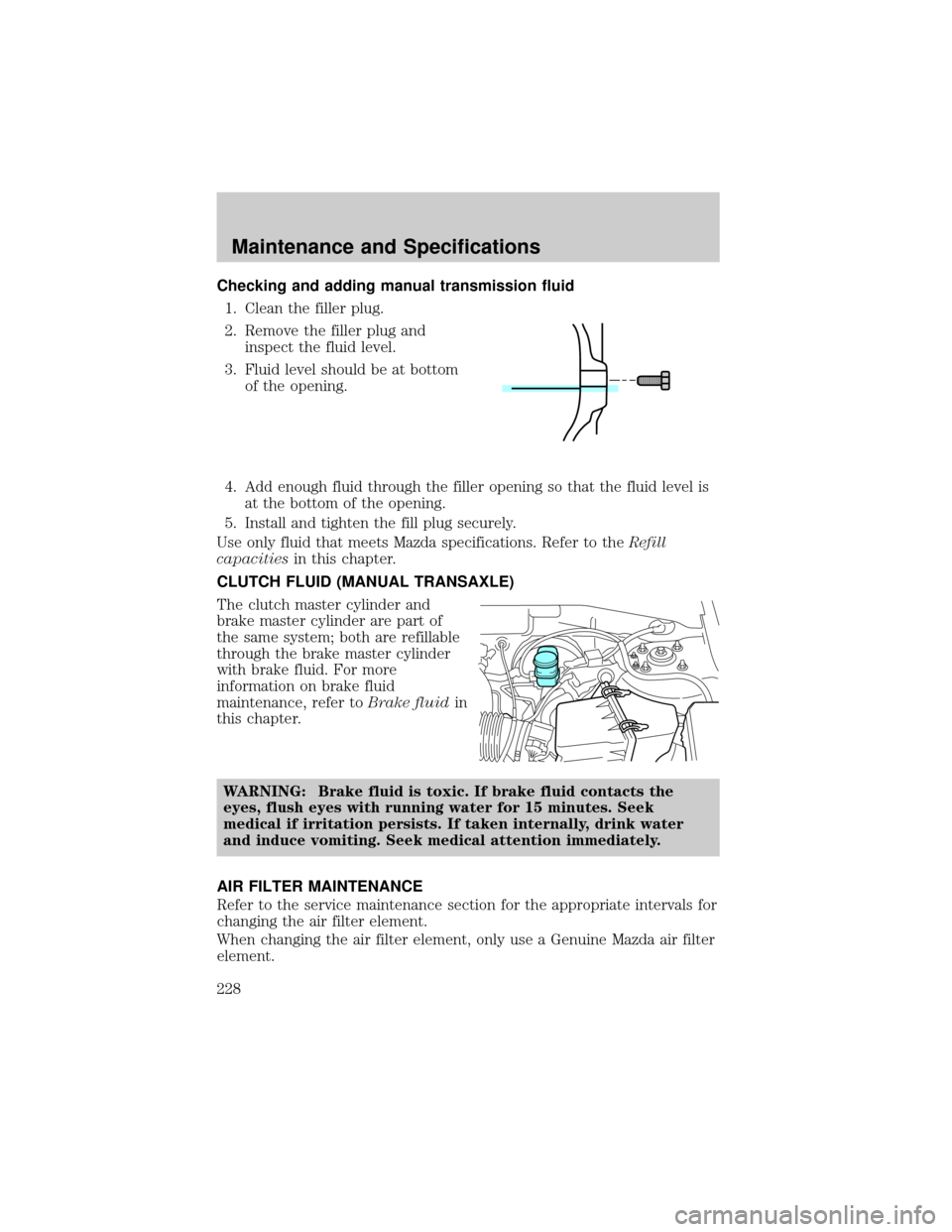check transmission fluid MAZDA MODEL TRIBUTE 2003 Owners Manual (in English)
[x] Cancel search | Manufacturer: MAZDA, Model Year: 2003, Model line: MODEL TRIBUTE, Model: MAZDA MODEL TRIBUTE 2003Pages: 248, PDF Size: 2.5 MB
Page 127 of 248

The BRAKE warning lamp in the
instrument cluster illuminates and
remains illuminated (when the
ignition is turned ON) until the
parking brake is released.
WARNING: Always set the parking brake fully and make sure
that the gearshift is securely latched in P (Park) (automatic
transmission) or in 1 (First Gear) (manual transmission).
NOTE:The parking brake is not recommended to stop a moving vehicle.
However, if the normal brakes fail, the parking brake can be used to stop
your vehicle in an emergency. Since the parking brake applies only the
rear brakes, the vehicle's stopping distance will increase greatly and the
handling of your vehicle will be adversely affected.
To release the parking brake, the
brake handle may need to be pulled
up slightly to release pressure
before pushing in the button.
Push the button on the end of
the parking brake handle and
push the handle down as far as
possible. Driving with the
parking brake applied will cause
the brakes to wear out quickly
and reduce fuel economy.
STEERING
To prevent damage to the power steering system:
²Never hold the steering wheel at its furthest turning points (until it
stops) for more than a few seconds when the engine is running.
²Do not operate the vehicle with a low power steering pump fluid level
(below the MIN mark on the reservoir).
If the power steering system breaks down (or if the engine is turned
off), you can steer the vehicle manually, but it takes more effort.
If the steering wanders or pulls, check for:
²an underinflated tire
²uneven tire wear
²loose or worn suspension components
²loose or worn steering components
²improper steering alignment
!
BRAKE
Driving
127
Page 147 of 248

DRIVING THROUGH WATER
Do not drive quickly through standing water, especially if the
depth is unknown. Traction or brake capability may be limited
and if the ignition system gets wet, your engine may stall. Water
may also enter your engine's air intake and severely damage your
engine.
If driving through deep or standing water is unavoidable, proceed very
slowly. Never drive through water that is higher than the bottom of the
hubs (for trucks) or the bottom of the wheel rims (for cars).
Once through the water, always try the brakes. Wet brakes do not stop
the vehicle as effectively as dry brakes. Drying can be improved by
moving your vehicle slowly while applying light pressure on the brake
pedal.
Driving through deep water where the transmission vent tube is
submerged may allow water into the transmission and cause
internal transmission damage. Have the fluid checked and, if
water is found, replace the fluid.
VEHICLE LOADING
Before loading a vehicle, familiarize yourself with the following terms:
²Base Curb Weight:Weight of the vehicle including any standard
equipment, fluids, lubricants, etc. It does not include occupants or
aftermarket equipment.
²Payload:Combined maximum allowable weight of cargo, occupants
and optional equipment. The payload equals the gross vehicle weight
rating minus base curb weight.
²GVW (Gross Vehicle Weight):Base curb weight plus payload
weight. The GVW is not a limit or a specification.
²GVWR (Gross Vehicle Weight Rating):Maximum permissible total
weight of the base vehicle, occupants, optional equipment and cargo.
The GVWR is specific to each vehicle and is listed on the Safety
Certification Label on the driver's door pillar.
²GAWR (Gross Axle Weight Rating):Carrying capacity for each axle
system. The GAWR is specific to each vehicle and is listed on the
Safety Certification Label on the driver's door pillar.
²GCW (Gross Combined Weight):The combined weight of the
towing vehicle (including occupants and cargo) and the loaded trailer.
²GCWR (Gross Combined Weight Rating):Maximum permissible
combined weight of towing vehicle (including occupants and cargo)
and the loaded trailer.
Driving
147
Page 197 of 248

SERVICE RECOMMENDATIONS
To help you service your vehicle:
²We highlight do-it-yourself items in the engine compartment for easy
location.
²We provide a Scheduled Maintenance section which makes tracking
routine service easy.
If your vehicle requires professional service, your dealership can provide
necessary parts and service. Check your ªWarranty Informationº to find
out which parts and services are covered.
Use only recommended fuels, lubricants, fluids and service parts
conforming to specifications. Genuine Mazda parts are designed and built
to provide the best performance in your vehicle.
PRECAUTIONS WHEN SERVICING YOUR VEHICLE
WARNING: A hot engine is dangerous. If the engine has been
running, parts of the engine compartment can become very hot.
You could be burned. Don't inspect the coolant system or add
coolant when the engine is hot.
²Do not work on a hot engine.
²Make sure that nothing gets caught in moving parts.
²Do not work on a vehicle with the engine running in an enclosed
space, unless you are sure you have enough ventilation.
²Keep all open flames and other lit material away from the battery and
all fuel related parts.
Working with the engine off
²Automatic transmission:
1. Set the parking brake and shift to P (Park).
2. Turn off the engine and remove the key.
3. Block the wheels.
²Manual transmission:
1. Set the parking brake, depress the clutch and place the gearshift in 1
(First).
2. Turn off the engine and remove the key.
3. Block the wheels.
Maintenance and Specifications
197
Page 226 of 248

TRANSMISSION FLUID
Checking automatic transmission fluid
Refer to your scheduled maintenance section for scheduled intervals for
fluid checks and changes. Your transaxle does not consume fluid.
However, the fluid level should be checked if the transaxle is not working
properly, i.e., if the transaxle slips or shifts slowly or if you notice some
sign of fluid leakage.
Automatic transmission fluid expands when warmed. To obtain an
accurate fluid check, drive the vehicle until it is warmed up
(approximately 30 km [20 miles]). If your vehicle has been
operated for an extended period at high speeds, in city traffic
during hot weather or pulling a trailer, the vehicle should be
turned off for about 30 minutes to allow fluid to cool before
checking.
1. Drive the vehicle 30 km (20 miles) or until it reaches normal
operating temperature.
2. Park the vehicle on a level surface and engage the parking brake.
3. With the parking brake engaged and your foot on the brake pedal,
start the engine and move the gearshift lever through all of the gear
ranges. Allow sufficient time for each gear to engage.
4. Latch the gearshift lever in P (Park) and leave the engine running.
5. Remove the dipstick, wiping it clean with a clean, dry lint free rag. If
necessary, refer toIdentifying components in the engine
compartmentin this chapter for the location of the dipstick.
6. Install the dipstick making sure it is fully seated in the filler tube.
7. Remove the dipstick and inspect the fluid level. The fluid should be
in the crosshatch zone for normal operating temperature.
Low fluid level
Do not drive the vehicle if the fluid
level is at the bottom of the dipstick
and the outside temperatures are
above 10ÉC (50ÉF).
Correct fluid level
The transmission fluid should be checked at normal operating
temperatures 66ÉC-77ÉC (150ÉF-170ÉF) on a level surface. The normal
operating temperature can be reached after approximately 30 km (20
miles) of driving.
Maintenance and Specifications
226
Page 228 of 248

Checking and adding manual transmission fluid
1. Clean the filler plug.
2. Remove the filler plug and
inspect the fluid level.
3. Fluid level should be at bottom
of the opening.
4. Add enough fluid through the filler opening so that the fluid level is
at the bottom of the opening.
5. Install and tighten the fill plug securely.
Use only fluid that meets Mazda specifications. Refer to theRefill
capacitiesin this chapter.
CLUTCH FLUID (MANUAL TRANSAXLE)
The clutch master cylinder and
brake master cylinder are part of
the same system; both are refillable
through the brake master cylinder
with brake fluid. For more
information on brake fluid
maintenance, refer toBrake fluidin
this chapter.
WARNING: Brake fluid is toxic. If brake fluid contacts the
eyes, flush eyes with running water for 15 minutes. Seek
medical if irritation persists. If taken internally, drink water
and induce vomiting. Seek medical attention immediately.
AIR FILTER MAINTENANCE
Refer to the service maintenance section for the appropriate intervals for
changing the air filter element.
When changing the air filter element, only use a Genuine Mazda air filter
element.
Maintenance and Specifications
228
Page 240 of 248

A
ABS (see Brakes) .....................125
Accessory delay ..........................61
Air bag supplemental
restraint system ..................99, 104
and child safety seats ............101
description ........................99, 104
disposal ............................103, 107
driver air bag ..................101, 106
indicator light .................103, 107
operation .........................101, 106
passenger air bag ...........101, 106
side air bag ..............................104
Air cleaner filter ...............228±229
Air conditioning
manual heating and air
conditioning system .................44
All Wheel Drive (AWD),
driving off road .........................137
Ambulance packages ....................5
Antifreeze
(see Engine coolant) ................209
Anti-lock brake system
(see Brakes) ......................125±126
Anti-theft system ........................78
arming the system ....................78
disarming a triggered system ..78
Audio system (see Radio) ...17, 27
Automatic transaxle
driving with .............................131
fluid, adding ............................226
fluid, checking ........................226
Automatic transmission ............128
fluid, refill capacities ..............234
Auxiliary power point .................59Axle
refill capacities ........................234
B
Battery .......................................207
acid, treating emergencies .....207
jumping a disabled battery ....169
maintenance-free ....................207
servicing ..................................207
Brakes ........................................124
anti-lock ...........................125±126
anti-lock brake system (ABS)
warning light ...........................126
fluid, checking and adding ....225
fluid, refill capacities ..............234
fluid, specifications .................236
lubricant specifications ..........236
parking ....................................126
shift interlock ..........................128
Break-in period .............................4
Bulbs ............................................51
C
Calculating load ........................149
Capacities for refilling fluids ....234
Cargo area shade ........................66
CD-single .....................................17
Cell phone warning ...................239
Certification Label ....................238
Child safety restraints ..............108
child safety belts ....................108
Child safety seats ......................112
attaching with tether straps ..116
in front seat ............................113
in rear seat ..............................113
Index
240
Page 241 of 248

Cleaning your vehicle
engine compartment ..............188
instrument panel ....................190
interior .....................................190
interior trim ............................190
Mazda car care products .......191
plastic parts ............................189
washing ....................................187
waxing .....................................187
wheels ......................................188
wiper blades ............................189
Climate control (see Air
conditioning or Heating) ............44
Clock ......................................26, 39
Clutch
fluid ..........................................228
operation while driving ..........134
recommended shift speeds ....135
Console ........................................66
overhead ....................................58
Controls
power seat .................................81
Coolant
checking and adding ..............209
refill capacities ................213, 234
specifications ..........................236
Cruise control
(see Speed control) ....................62
Customer
Assistance ..................176±177, 180
D
Daytime running lamps
(see Lamps) ................................48
Defrost
rear window ..............................47Dipstick
automatic transmission
fluid ..........................................226
engine oil .................................203
Driving under special
conditions ..................133, 140, 143
sand .........................................142
snow and ice ...........................144
through water .................142, 147
E
Emergencies, roadside
jump-starting ..........................169
Emission control system ..........222
Engine ........................................236
cleaning ...................................188
coolant .....................................209
idle speed control ...................207
lubrication specifications .......236
refill capacities ........................234
service points ..................200±201
Engine block heater .................123
Engine oil ..................................203
checking and adding ..............203
dipstick ....................................203
filter, specifications ................206
recommendations ...................206
refill capacities ........................234
specifications ..........................236
Exhaust fumes ..........................123
F
Fluid capacities .........................234
Foglamps .....................................48
Four-Wheel Drive vehicles
description ..............................138
driving off road .......................139
indicator light .........................138
Index
241
Page 243 of 248

K
Keys
positions of the ignition .........120
L
Lamps
bulb replacement
specifications chart ..................51
cargo lamps ...............................49
daytime running light ...............48
fog lamps ...................................48
headlamps .................................48
headlamps, flash to pass ..........49
instrument panel, dimming .....49
interior lamps .....................50±51
replacing bulbs ...................51±55
Lane change indicator
(see Turn signal) ........................50
Liftgate ........................................67
Lights, warning and indicator ....10
anti-lock brakes (ABS) ..........126
Load limits .................................147
GAWR ......................................147
GVWR ......................................147
trailer towing ..........................147
Loading instructions .................149
Locks
childproof ..................................70
doors ..........................................69
Lubricant specifications ...........236
Lumbar support, seats .........80±81
M
Manual transaxle .......................134
fluid, checking and adding ....228
reverse .....................................136Manual transmission
fluid capacities ........................234
Mirrors ...................................59, 61
fold away ...................................62
heated ........................................62
side view mirrors (power) .......61
Moon roof ....................................66
Motorcraft parts ........................219
O
Octane rating ............................217
Oil (see Engine oil) ..................203
Overdrive ...................................130
Overheating ...............................162
P
Parking .......................................136
Parking brake ............................126
Power distribution box
(see Fuses) ...............................159
Power door locks ........................69
Power point ...........................59±60
Power Seats .................................81
Power steering ..........................127
fluid, checking and adding ....224
fluid, refill capacity ................234
fluid, specifications .................236
Power Windows ...........................60
Preparing to drive your
vehicle ........................................128
R
Radio ......................................17, 27
Radio reception .....................42±43
Index
243
Page 244 of 248

Rear window defroster ...............47
Relays ........................................156
Remote entry system
illuminated entry ......................74
locking/unlocking doors ...........69
Roof rack .....................................68
S
Safety belts (see Safety
restraints) ..............................89±93
Safety defects, reporting ..........186
Safety restraints ....................89±94
cleaning the safety belts ..........98
extension assembly ..................95
for adults .............................90±93
for children .............................108
lap belt ......................................95
warning light and chime ..........96
Safety seats for children ..........112
Seat belts
(see Safety restraints) ...............89
Seats ............................................79
child safety seats ....................112
heated ........................................82
Servicing your vehicle ..............197
Spare tire (see Changing
the Tire) ............................163±164
Spark plugs, specifications .......236
Special notice
ambulance conversions ..............5
Specification chart,
lubricants ...................................236
Speed control ..............................62
Starting your vehicle ........120±122jump starting ..........................169
Steering wheel
tilting .........................................58
T
Tires ...................................229±231
changing ..........................163±165
checking the pressure ............231
replacing ..................................232
rotating ....................................231
snow tires and chains ............233
tire grades ...............................230
treadwear ................................230
Towing .......................................149
recreational towing .................154
trailer towing ..........................149
wrecker ....................................174
Transaxle
fluid, checking and adding
(manual) .................................228
manual operation ....................134
Transmission
automatic operation ...............128
fluid, checking and adding
(automatic) .............................226
fluid, refill capacities ..............234
Turn signal ..................................50
V
Vehicle dimensions ...................236
Vehicle Identification Number
(VIN) ..........................................238
Vehicle loading ..........................147
Ventilating your vehicle ...........124
Index
244